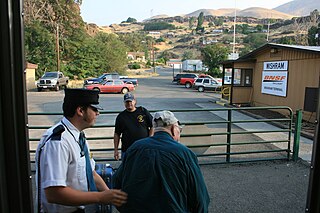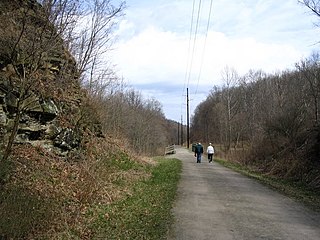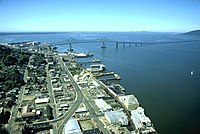
Wishram is an unincorporated community and census-designated place (CDP) in Klickitat County, Washington, United States. The population was 342 at the 2010 census, up from 213 at the 2000 census. The site of the historic Celilo Falls is nearby.
The Wallooskee River is a tributary of the Youngs River, about 10 miles (16 km) long, in northwest Oregon in the United States. It drains a small area of the foothills of the Coast Range near the mouth of the Columbia River. The Youngs River is a tributary of the Columbia River.

The Astoria–Megler Bridge is a steel cantilever through truss bridge in the northwest United States that spans the lower Columbia River, between Astoria, Oregon, and Point Ellice near Megler, Washington. Opened 57 years ago, in 1966, it is the longest continuous truss bridge in North America.

The John Day River is a tributary of the Columbia River, approximately 6 miles (10 km) long, in northwestern Oregon in the United States. The river rises in the Northern Oregon Coast Range in Clatsop County at 46.138889°N 123.704722°W.

A trestle bridge is a bridge composed of a number of short spans supported by closely spaced frames. A trestle is a rigid frame used as a support, historically a tripod used to support a stool or a pair of isosceles triangles joined at their apices by a plank or beam such as the support structure for a trestle table. Each supporting frame is a bent. A trestle differs from a viaduct in that viaducts have towers that support much longer spans and typically have a higher elevation.

The OC&E Woods Line State Trail is a rail trail in Klamath and Lake counties in the U.S. state of Oregon. It is Oregon's longest state park. The trail follows the old OC&E and Weyerhaeuser railroads from Klamath Falls to Thompson Reservoir. Along its 105-mile (169 km) length it passes through the communities of Olene, Sprague River, Dairy, Beatty, and Bly.

The Montour Trail is a multi-use recreational rail trail near Pittsburgh, Pennsylvania. It was formerly the Montour Railroad.

The Sacramento Northern Railway was a 183-mile (295 km) electric interurban railway that connected Chico in northern California with Oakland via the California capital, Sacramento. In its operation it ran directly on the streets of Oakland, Sacramento, Yuba City, Chico, and Woodland and ran interurban passenger service until 1941 and freight service into the 1960s.

The Metropolitan Subdivision is a railroad line owned and operated by CSX Transportation in the District of Columbia and the U.S. state of Maryland. The 79-mile line runs from Washington, D.C., northwest to Weverton, Maryland, along the former Metropolitan Branch of the Baltimore and Ohio Railroad.
The Ilwaco Railway and Navigation Company operated a 3 ft narrow gauge railroad that ran for over forty years from the bar of the Columbia River up the Long Beach Peninsula to Nahcotta, Washington, on Willapa Bay. The line ran entirely in Pacific County, Washington, and had no connection to any outside rail line. The railroad had a number of nicknames, including the "Clamshell Railroad" and the "Irregular, Rambling and Never-Get-There Railroad."

The Kate Shelley High Bridge, officially called the Boone Viaduct when it was completed in 1901, is one of the highest and longest double-track railroad bridges in the United States. It is located approximately 3 miles (4.8 km) west of Boone, Iowa.
Rail transportation is an important element of the transportation network in the U.S. state of Oregon. Rail transportation has existed in Oregon in some form since 1855, and the state was a pioneer in development of electric railway systems. While the automobile has displaced many uses of rail in the state, rail remains a key means of moving passengers and freight, both within the state and to points beyond its borders.

The Columbia Plateau State Park Trail is a 130-mile-long (210 km), 20-foot-wide (6.1 m) corridor in eastern Washington state maintained as part of the Washington State Park system. The rail trail runs along the abandoned right-of-way of the former Spokane, Portland and Seattle Railway.
The Dakota Rail Trail runs 28.1 miles (42.6 km) from Wayzata to Lester Prairie, Minnesota. It is on part of the former track bed of the Hutchinson Spur of the Great Northern Railway. The railway line helped bring wheat and raw materials from Central Minnesota to the flour mills, factories and wearhouses in Minneapolis from 1885 until 2001. The railway line, from which there are views of the countryside, was also designed to bring tourists to the communities on Lake Minnetonka in the late 1880s.

The Port of Tillamook Bay Railroad (POTB) was a 101-mile (163 km) shortline railroad in northwestern Oregon in the United States. Purchased from the Southern Pacific Transportation Company in 1990 by the Port of Tillamook Bay, the railroad was used to transport lumber and agricultural products over the Northern Oregon Coast Range between the Oregon Coast and the Portland area until heavily damaged in a 2007 storm. The Port of Tillamook Bay began operating the unincorporated railroad on March 27, 1986, but the tracks were originally constructed by Oregon judge George R. Bagley and others in 1906. The railroad's main line, no longer in use due to storm damage, runs between Hillsboro and Tillamook.

The Astoria Riverfront Trolley is a 3-mile (4.8 km) heritage streetcar line that operates in Astoria, Oregon, United States, using former freight railroad tracks along or near the south bank of the Columbia River, with no overhead line. The service began operating in 1999, using a 1913-built streetcar from San Antonio, Texas. As of 2012, the service was reported as carrying 35,000 to 40,000 passengers per year and has been called a "symbol" and "icon" of Astoria. The line's operation is seasonal, normally during spring break and from May through September.
The Crooked River Railroad Bridge, part of a BNSF Railway line between the Columbia River and Bend, Oregon, crosses Oregon's Crooked River Canyon in southern Jefferson County. The bridge is 320 feet (98 m) above the river and when it was completed in 1911, it was the second-highest railroad bridge in the United States. It is a steel two-hinge arch span with a total length of 460 feet (140 m).

The Dumbarton Rail Bridge lies just to the south of the Dumbarton road bridge. Built in 1910, the rail bridge was the first structure to span San Francisco Bay, shortening the rail route between Oakland and San Francisco by 26 miles (42 km). The last freight train traveled over the bridge in 1982, and it has been proposed since 1991 to reactivate passenger train service to relieve traffic on the road bridges, though this would entail a complete replacement of the existing bridge. Part of the western timber trestle approach collapsed in a suspected arson fire in 1998.

The New Youngs Bay Bridge is a vertical-lift bridge over Youngs Bay on U.S. Route 101 (US 101) between Astoria and Warrenton. Including the approaches, it is 4,200 feet (1,300 m) long and was completed in 1964. The road bridge had been proposed since 1948 and was approved by the state government in the late 1950s.

Nahcotta was a steamboat operated from 1898 to 1928 on a route from Astoria, Oregon to Ilwaco, Washington, and then, from 1908 on, from Astoria to Megler, Washington. Nahcotta ran on the same route for its entire service life, and for much of that time was commanded by Capt. Tom Parker, who started his marine career as a deckhand and who had only three months of formal education.
















